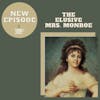The Elusive Mrs. Monroe

The women behind the great men in history are often forgotten and overlooked. No one quite exemplifies this as much as Elizabeth Monroe, the wife of the fifth president of the United States, James Monroe.
Join me this week as I discuss her life and her impact - and why her story isn't well known.
SOURCES:
Gould, Lewis L.. American First Ladies: Their Lives and Their Legacy. N.p.: Taylor & Francis, 2021.
Hart, Gary. James Monroe. New York: Times Books, 2005.
“Elizabeth Monroe.” UVA Miller Center.
https://millercenter.org/president/monroe/essays/monroe-1817-firstlady
Ellizabeth Monroe. The National First Ladies Library.
http://www.firstladies.org/biographies/firstladies.aspx?biography=5
Support the show (http://www.buymeacoffee.com/civicscoffeepod)
Welcome to Civics and Coffee. My name is Alycia and I am a self-professed history nerd. Each week, I am going to chat about a topic on U.S history and give you both the highlights and occasionally break down some of the complexities in history; and share stories you may not remember learning in high school. All in the time it takes to enjoy a cup of coffee.
INTRO MUSIC
The Elusive Mrs. Monroe
Hey Everyone, welcome back.
So a little note about me before I dive into this week’s topic. You all know I am a history nerd. However, to fill out the picture even more, years ago I had a list of a bunch of things I wanted to do before I turned thirty. One of those was to read a biography of every U.S. president.
In history classes, we are taught about the various presidents but given there is so much to cover and often so little time, a lot of the lesser known men who served as presidents get glossed over and I knew I wanted to read in depth about each of them. While I didn’t make my timeline, I did in fact read a biography of every president through Clinton. I decided to stop at Clinton since I felt there hadn’t been a sufficient passage of time to get into the Bush years and I wasn’t sure I was ready to analyze his presidency at that moment.
One of the things that has been on the list ever since accomplishing this goal is to also read a biography of each first lady. While some presidents may get forgotten or undercovered, the women who served in the roles of hostess and wife fall victim to obscurity far more often. Case in point, today’s topic Mrs. Elizabeth Kortright Monroe.
I scoured the interwebs, libraries and social media outlets to track down a substantive biography of the wife of the fifth president of the United States, however I came up short. Women play such an important role in the lives of the great and flawed men of our history, and I was so disheartened to learn that a thorough and detailed portrait of her life just wasn’t available. But I was still committed to sharing her life, so I decided to go ahead and find out what I could about Mrs. Monroe and put together an episode. As such, this may be a bit shorter than usual.
So who was Elizabeth Kortright Monroe? And why is she missing from the biography shelves?
Grab your cup of coffee, peeps. Let’s do this.
Elizabeth Kortright Monroe was born on June 30th, 1768 in New York to a prominent family. Her father, Lawrence, was a New York merchant who served the crown privateering during the French & Indian War. Her mother, Hannah, birthed several other children, giving Elizabeth three sisters and one brother. Like most women of this time, very little is known about Elizabeth’s youth.
It was very rare for women of the time to maintain any personal records or enter into contracts. Compound this with the fact that many women were given very little education and capturing Elizbeth’s voice is a bit elusive. The Kortright’s were a wealthy family who were loyal to the crown, something that became a bone of contention for Elizabeth as the Revolution broke out. Given New York was at the center of the battles of the revolution, being a known loyalist likely led to some social ostracizing for Elizabeth in her formative years. This experience likely gave her the strong back bone she’d need during her marriage and political criticism she’d face while being a Washington wife.
As I mentioned last week, she married James Monroe on February 16th, 1786 at her parents home. She was only seventeen to James’ twenty seven. From the limited information available it appears as though their marriage was a happy one and they had three children: Eliza born the year the two were wed in 1786, James Spence born in 1799 who died as a toddler in 1800 and Maria Hester born in 1803.
Much like the women of the time, Elizabeth followed James through his various diplomatic posts, traveling with him overseas to Europe first in 1794 after he was appointed to the post of U.S. Minister to France. Elizabeth made quite the impression during her time in Paris, making a very public visit to Adrienne de Noiolles de Lafayette - the imprisoned wife of the Marqui de Lafayette. The Lafayette’s were a personal friend of the president and had a tremendous amount of support in America due to his assistance during the revolution. Her visit helped secure Madame’ Lafayette’s release, endearing her to the French who took to calling her La Belle Americane.
Elizabeth seemed to gravitate towards and enjoy the protocol prominent in Europe and used these experiences later during her tenure as White House hostess which rubbed more than a few Washington elites the wrong way.
Upon his recall as minister in 1796, Monroe came back stateside and served as Governor. While he served in the capital city of Richmond, Elizabeth split her time often traveling between the capital and their home in Charlottesville. It was during Monroe’s first tenure as Governor their only son James passed away. The cause of death is unknown, only that he died after being ill for several days. It was shortly after her son’s death that Elizabeth began to exhibit some severe health complications, believed today to be epilepsy
Her seizures were apparently so intense that during one such fit, she fell into a fireplace and was badly burned. She also suffered from headaches, which combined with her quiet and formal nature, led to her withdrawing from public life later in Monroe’s political career.
Speaking of career, in 1803 Monroe was asked to assist Robert Livingston in the negotiations to acquire the Louisiana Territory, thereby requiring the Monroe’s to pack up and head back overseas. While working in France, he was called upon to serve as the U.S. Minister to Britain.
Having had a memorable and pleasurable experience during their time in France, one can I think safely assume that Elizbeth was looking forward to seeing the country her father so faithfully served. However, Britain did not seem to care for the Monroes. As I mentioned in my episode on James Monroe last week, his success as a diplomat was inconsistent and underwhelming, but not due to any shortcomings or incompetence on his part. Monroe mainly fell victim to the political climate and during his tenure as Minister to Britain, temperatures were frosty.
The cool reception of the Monroe’s in Britain of course spilled onto Elizabeth who was ostracized and left out of the British social circle. As fate would have it, this experience also prepared Elizabeth for her time as first lady.
But before he was elected president of the United States, Monroe served as the Secretary of State for James Madison. Elizabeth did not immediately join her husband upon his appointment, staying behind in Virginia for almost a year before making the journey to be with her husband. She kept a quiet house, rarely entertaining guests. This was partially due to their ever growing debt as a result of serving as a diplomat and partially to ensure no one upstaged the president and first lady. However, once in the hot seat herself, Elizabeth could no longer avoid the requirements that came with being the most prominent woman in DC.
On March 4th, 1817 James Monroe was sworn in as the fifth president of the United States. The Madisons took their leave, including the ever popular and highly cherished Dolley Madison. The contrast between Dolley and Elizabeth was stark; Dolley was an avid entertainer and gracious host, leaning into a public life filled with receiving diplomats and returning social calls. Elizabeth, however, preferred to keep things formal and, in part due to her health, did not make the rounds to visit the various Washington wives.
There is no record of Elizabeth attending the inauguration, historic in that it was the first inaugural address held outdoors due to bickering in Congress. Congress? Bickering? You don’t say. It also appears as though Elizbeth did not participate in the reception at their home. Perhaps she fell ill or maybe she was trying to implement a more formal protocol. Unfortunately, we will never know for sure.
And unlike other first ladies, it seems as though Elizabeth did not take an active role in decorating the presidential mansion, leaving the details to her husband. However, hostess duties were a requirement of the wife of the president of the United States and so Elizabeth did what she thought best when planning receptions. She relied on her daughter Eliza to help with hosting which did not go over so well. Eliza was seen as bossy and did not have a defined role within the white house. So even though she occasionally subbed in for her mother, she definitely was not Elizabeth and her acting as if she were - in their eyes - only further alienated people.
The protocols surrounding receiving diplomats became such an issue that Monroe held a cabinet meeting on December 29, 1817 to try to wrap his head around the requirements. During this meeting, Elizabeth and Louisa Adams, wife of Secretary of State John Quincy Adams, also met to determine how to properly define their roles as political wives. Shortly after this meeting, Elizabeth set about formalizing the process for receptions at the presidential mansion with Louisa following suit. Hosted dinners were done in English style, meaning there was one servant for each guest present. This was something Elizabeth saw during her time overseas and sought to replicate to establish a sense of gravitas for the evolving nation.
The protocols were a hit when receiving European heads of state, who were used to the formalities involved. For the DC establishment, however, the protocols seemed stiff and further alienated them. While the wives of the political men of DC felt snubbed, there was likely more at play than Elizabeth’s desire to impress foreign diplomats. Due to her weak health, having informal receptions and traveling to return social calls was likely out of the question.
Elizabeth struggled throughout her time as first lady - both physically as well as socially. Not only was she suffering from what is believed to be epilepsy and headaches, but she also began suffering from rheumatism. Exhausted from the pain, she likely kept quiet to hide any discomfort; this behavior was initially construed as a sense of entitlement and led to rumors she felt she was a queen. Visitors also noticed and pointed out the large quantity of French furniture throughout the house, using that as further evidence of her aristocratic leanings.
What they didn’t know, of course, was the pieces were purchased in France after the Monroe’s had to sell their original furniture to afford the costs of traveling overseas during Monroe’s various diplomatic posts. A lot of Elizabeth’s experiences remind of a high school popularity contest. She, her daughter and Louisa Adams were all socially boycotted throughout 1819 due to their implementation of the more ceremonial reception practices. Tensions continued to build when the Monroe’s committed the ultimate sin and failed to open up their daughter’s wedding at the mansion in 1820 to the general public, choosing to keep it a private, family only affair. The shame.
The ostracism got so intense that it began to impact domestic politics, requiring intervention from John Quincy Adams. Balancing Elizabeth’s reserved nature, desire to elevate the status of the presidential mansion and her health with the desire of a more democratic approach to access to the first family, a compromise was reached. White house dinners were to continue to be formal in the English style Elizabeth established. However, they’d also host more informal meetings, known as levees, every couple of weeks.
This seemed to do the trick and the social freeze eventually thawed as Elizabeth was accepted for who she was. Guests trickled into the mansion throughout Monroe’s second term, however Elizabeth made fewer and fewer official appearances. While we cannot know for sure the reasons, it seems as though her deteriorating health was the primary factor. Even vacating the house once Monroe’s term was over was delayed due to Elizabeth’s inability to travel.
The Monroe’s were able to enjoy five years of retirement together before Elizabeth passed away on September 23, 1830 at the age of 62. Upon her death, James ordered a double vault for both of their remains, delaying her funeral until it was complete. He was devastated at the loss of his wife. In one of the few remaining letters detailing the depth of his emotions for Elizabeth, James wrote to a friend quote, “After having lived, with the partner of your life, in so many vicissitudes of life, so long together and afforded to each other the comforts which no other person on earth could do, as both of us have done, to have her snatched from us, is an affliction which none but those who feel it can justly estimate” end quote.
Monroe was convinced he would not live long without his dearly beloved and he was right. He died less than a year later on July 4th, 1831. And though he made arrangements to be buried along with his wife, his wishes were delayed as he was originally buried in New York. It wasn’t until several years later that he was transported back to Virginia and buried alongside his wife.
So why is there no detailed biography of the wife of our fifth president? Well, it stems from the lack of primary source material. She kept no diaries we know of; or if she did, her husband ensured their destruction. And Monroe left little trace of his feelings about his wife, which leaves us with limited, outsider perspectives. While the information available about Elizabeth Kortright Monroe comes from the observations of others, she nevertheless made her own mark on the city and on the man who would be her husband for forty years. She aided her husband in his diplomatic posts, extending friendship and protection to a couple who were held in high regard back home and she helped elevate the status of the presidency by implementing protocols that, while initially troublesome, became accepted and to some degree, followed by her successors.
I wish we knew more about her.
If you’ve been enjoying the show, please consider a rate and review. A few weeks back Spotify implemented their own version of a ranking system - so if spotify is your player of choice, look for it on the show’s description on your player. You can also drop reviews on places like podchaser, good pods and apple podcasts.
If you ever have a topic in mind, let me know - I love covering guest requests. You can find me on the socials - instagram at civics and coffee, twitter at civicspod, facebook and civics and coffee and if you’ve decided you want to have a social media free 2022, you can always hit me up on the website www dot civics and coffee dot com.
Thanks peeps. See you next week.
Thanks for tuning and I hope you enjoyed this episode of Civics & Coffee. If you want to hear more small snippets from american history, be sure to subscribe wherever you get your podcasts. Thanks for listening and I look forward to our next cup of coffee together.
OUTRO MUSIC
Listener Favorites
Not sure where to begin? Take a listen to some fan favorites.

























